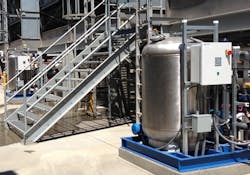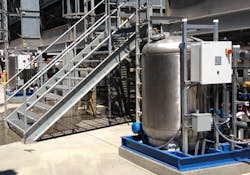Case Study: Cross-flow microsand filtration boosts energy efficiency, savings for Canada deep water cooling system
Nov. 19, 2014
Enwave Energy Corporation, one of the largest district energy providers in North America, recently enhanced its innovative Deep Water Lake Cooling capabilities with the installation of an advanced, high-efficiency filtration system into its 10-mile recirculation water loop. Enwave's chilled water system, which cools the air of over 30 buildings in the financial district of Toronto, Ontario, is now seeing improved performance and energy conservation due to the removal of suspended impurities in the water as well as some of the related biological organisms that would otherwise compromise system efficiency.
In service since 2004, the Enwave cooling system uses 39.2˚F icy-cold water (4˚C) from 272 feet (83 meters) below Lake Ontario's surface to create a chilled water loop that brings an alternate to conventional air conditioning for cooling Toronto's downtown core, making the city a leader in sustainable energy. Three Enwave intake pipes draw permanently cold water from the depths offshore to the city's John Street Pumping Station, where heat exchangers enable the energy transfer between the icy cold lake water and the Enwave closed chilled water supply loop.
This cold energy of the 2.5-million-gallon subterranean loop has the capacity to cool 34.5 million square feet of office space, eliminating harmful ozone-depleting refrigerants (CFCs and HCFCs) and removing 79,000 tons of carbon dioxide from the air -- the equivalent of taking 15,800 cars off the road. The system will also save customers millions of dollars in electric power usage, providing price stability in a volatile energy market and reducing building owner exposure to peak electric power usage costs during morning hours when most conventional air conditioning systems are brought online.
Customer savings through Deep Lake Water Cooling were demonstrated after May 2006 when Hudson's Bay Company (HBC), Canada's oldest diversified general merchandise retailer, switched to Enwave's system for its 1,320,000-square-foot Toronto office tower. HBC energy savings are projected at 3,571,200 million kilowatts per year -- the equivalent of powering more than 350 homes.
Enwave desired to maintain water quality (in its chilled water loop) that meets potable water guidelines. It uses chlorine for disinfection and bioactivity control. By removing suspended solids (via filtration), it anticipated savings in chemical treatment costs and a reduced potential for distribution system corrosion. Other projected savings include reduction in labor costs associated with cleaning water system equipment, reduced risk of unscheduled downtime, and reduced electric power costs that would be incurred with a less efficient system.
"One of the keys to proving a healthy recirculating chilled water loop was to incorporate a water filtration system that would virtually eliminate suspended impurities," said Steve Martile, Enwave project manager. "Our cold water interfaces with heat exchangers in the buildings we chill, so suspended impurities could eventually coat the heat exchanger plates, making them less efficient. The suspended matter could also provide nutrients for biological growth that could create the same problem, resulting in added chlorine disinfection treatment costs or damaging the plates and pipes in the system."
Due to the energy transfer occurring at the city's John Street Pumping Station, removal of suspended water impurities in the range of 0.5 microns (potable water equivalency) was desirable. Enwave also recognized that continuous removal of suspended solids was a key factor in maintaining a clean chilled system.
In February 2005, Enwave issued a request for proposals for a filtration system that would provide the needed 0.5-micron filtration capability while sustaining a filtrate flow of 550 gallons per minute (GPM) 24/7. A high-efficiency Vortisand® centrifugal sand filtration system manufactured by Sonitec was recommended. The bid was won by Sonitec Inc., Montreal, Quebec - Canadian International HQ.
The Vortisand centrifugal filtration system uses a combination of in-situ, fine-sand centrifugal separation combined with down-flow sand filtration, which ensures greater filtration efficiency than traditional down-flow sand filters. Sonitec's centrifugal filtration systems are widely used for various process water polishing applications. This fully automated, unusually compact Vortisand system provides removal of solids to a miniscule 0.45 micron with filtration up to 20 GPM/square feet.
"We have experienced and encountered many concerns within the water treatment and HVAC industry regarding performance of multimedia sidestream sand filtration for systems such as Enwave's. But we have found the Sonitec design to be altogether different," said Ron Exelby, local representative. "This system uses centrifugal force through ultra-fine sand to filter particles down to 0.45 microns. Most multimedia filtration systems will go to 10 microns or five if they are nearing the end of their run. Most evaporative and closed recirculating systems suspended solids are <5 microns. The standard sand filter therefore by design and nature of the water, will be working on only 2 to 5 percent of the impurities, whereas the Vortisand will work on 97 to 98 percent of them -- down to 0.45 microns."
Through laser particle tests, Exelby, a 34-year veteran of the water treatment, found that approximately 97.5 percent of the suspended solids in the water in the Enwave cold water loop was less than 5 microns and approximately 86 percent less than 1 micron at the time of sampling.
The system selected and approved by Enwave and installed at the firm's Simcoe Street Chiller Plant consists of six 30-inch diameter Vortisand vessels (Model AWT6-30-SI), complete with a sand trap and automation in the control panel to allow for a clean-in-place (CIP) system. As an optional feature, Sonitec modified the software so that if the filtrate valve downstream of the filter remained closed when it should be open, then the filter system automatically shuts down.
"That is not a standard operating parameter on this filtration system," Exelby said, "but since we are pushing 550 gallons per minute, it was determined that if a downstream valve on the filtration system would stick for any reason after backwashing, then the filter pump would automatically shut down."
The filtration system's operator interface unit (OIU) is programmable, enabling the capability to automatically feed a chemical for media cleaning (after a predetermined number of backwashes). It is password protected, and the duration of the backwash is also adjustable by accessing the unit. The system also has alarms on the OIU that indicate when pre-scheduled maintenance is required. Alarms are also generated when high backwash frequency occurs (above a pre-determined frequency) or if the filter system sand trap should become plugged. An alarm is generated if the there is a pressure increase beyond the factory setting for the sand trap, and the system will also shut down. There is also a dry contact available on the filtration system panel that enables monitoring of the backwash float.
After installation of the new filtration system was completed, Enwave requested a 12-week evaluation of the Vortisand system's performance in September 2005. Throughout this period, XLB sampled the chilled water for laser particle testing. After the weekly tests were evaluated, it was determined that total particle count (all micron sizes) was reduced by 89.6 percent, and total suspended solids (TSS) reduced by 96.5 percent.
"Ultraviolet light absorption testing was equally impressive," Exelby said. "Prior to the installation of the new filtration system, the average reading was 92 percent, which meant that 8 percent of the light was being partially absorbed by suspended impurities in the water. After the Vortisand system was installed, that number went up to 95 percent."
Although the Vortisand filter is not marketed for biological control, the ability to remove impurities down to 0.45 microns may also results in the removal of larger bacteria. Vortisand filters are also widely used for reverse osmosis (RO) pretreatment.
See also:
"Case Study: DC five-star hotel overcomes cooling tower sludge issues with advanced sand filter"
"Case Study: Filter reduces flood-induced suspended solids in New Orleans heat exchangers"
About Sonitec
Sonitec was founded in 1986 offering an innovative technology: the Vortisand. Behind each Vortisand system you will find a dedicated company with more than 2,500 installations worldwide. Certain innovations have allowed the company to become a specialist in filtration for pharmaceutical, petroleum refining, biotechnology, pulp & paper, automotive, and general HVAC sectors. Recent breakthrough installations include Vortisand filters on cooling systems of major projects operated by major market leaders such as eBay, Conoco-Philips, GM and more. For more information, visit www.sonitec.com/en/home.html.
###

